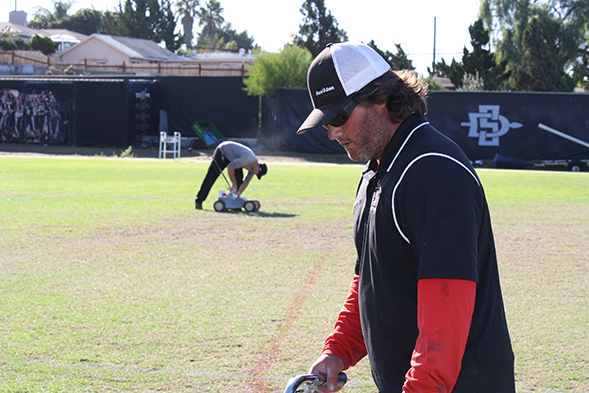A Team Effort
Behind the scenes, SDSU groundskeepers work to maintain beautiful fields and keep athletes safe.

When San Diego State University all-time leading rusher Donnel Pumphrey practices his lightning-quick moves on the natural turf field below the SDSU Sports Deck, he gives more thought to evading tacklers than to the condition of the grass beneath his flying feet. That’s just what Mike Markulin and Scott Maitoza want.“I get a thrill out of providing the best surface possible for the athletes so they can bring out their best abilities.”
The two groundskeepers are primarily responsible for the maintenance of the practice field and all of the other athletics fields on campus. Their job is to keep the fields in the best possible condition to help SDSU athletes succeed.
“You want them to be able to practice the way they want to practice,” said Markulin, who came to SDSU two years ago from the University of Pennsylvania, where he also maintained athletics fields. “You want them to be able to use the field the way it was intended to be used.”
Maintenance of the natural-turf practice field, as opposed to the synthetic surface field, is especially important to the football team this time of year because the Aztecs play their home games on a natural-grass field in Qualcomm Stadium. SDSU Landscape Services Manager Josh Koss says his staff’s top three priorities with the practice field and all of the other campus playing surfaces are safety, consistency and aesthetics.
"If the fields are safe we are doing our jobs and if they are consistent, it gives our athletes that home-field advantage because they know what they are walking onto," Koss explained. “If you really keep a safe and consistent field, the aesthetics are almost a byproduct.”
Divots and driving feet
Early Monday mornings, the Landscape Services team meets to go over assignments for the week. Priorities shift depending on the weather, with rain or drought heavily influencing the athletics field workers along with the needs of Aztec teams that may be practicing or competing at any given time of year.SDSU has just more than seven acres of natural-field surfaces including the SDSU Sports Deck, soccer field and the baseball and softball fields. Markulin and Maitoza agree the baseball and softball fields are the most difficult to maintain due to the extensive dirt work involved in their upkeep. Both say butsay the two-and-a-half -acre natural-turf football field takes the heaviest beating of all.
“You have a lot of divots to repair because the players get after the field really good and you see all the wear between the hash marks,” said Maitoza, who has a background in horticulture and has tended SDSU’s athletics fields for three years. “These are big boys putting a lot of resistance and force into the turf and the grass can only handle so much."
A passion for the work
The grass is a mixture of Tifway Bermuda on the outside of the field and the more aggressive, laterally growing Bandera Bermuda between the hash marks. In winter months, the field is also seeded with rye. The center of the field is re-sodded every two years.Depending on how it is growing, Maitoza and Markulin—who work Saturday through Wednesday—will mow and blow the football practice field between three and five times a week. Along with two student assistants, they spend every Tuesday morning repainting the lines on the field.
The two estimate they spend a third of their work week on that single field, and both are passionate about the work.
“Horticulture is my background, and I love being around sports,” Markulin said. “I have played sports my entire life—football and basketball—and I love being able to grow grass and being around athletes."
Maitoza grew up playing competitive soccer, but never thought about a career caring for sports turf.
“I get a thrill out of providing the best surface possible for the athletes so they can bring out their best abilities,” he said.
Succeeding together
The men's efforts do not go unappreciated. Jeff Horton, the football team's associate head coach, offensive coordinator, and running backs coach says he thinks the “tip-top shape” of the natural-turf practice surfaces has contributed to the success of SDSU’s football program.“We have set a school record this year in rushing and the majority of time we practice on the grass fields,” he said. “Our running backs have remained healthy as well, which I think you can partly attribute to well-maintained fields."
Whenever junior running back Rashaad Penny scores a touchdown with a kickoff return or Pumphrey takes another step toward becoming Division I college football’s all-time leading rusher, Markulin and Maitoza take satisfaction in knowing they played some part in the players’ successes.
“The biggest thing for Pumphrey and his speed is juke, his lateral moves,” said Markulin. “It's great to know that he can go out and do that on our practice field - practice to his full potential, put that into a game and be talked about as a Heisman candidate. It’s great for him and it’s great for San Diego State.”



